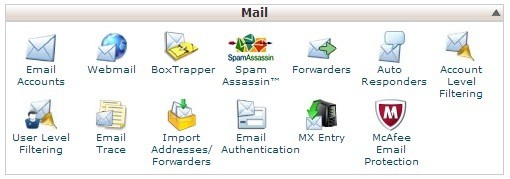Tooltester is supported by readers like yourself. We may earn an affiliate commission when you purchase through our links, which enables us to offer our research for free.
Tired of relentless spam emails continuously filling your inbox? As a small business owner, the last thing you need is wasting time shifting through your email.
Most small business websites have their email setup through their current web host. Unfortunately, setting your web host as your inbound email handler can open you up to a world of spam unless you also set up a spam blocker.
Your current web host should have something like this already in place, but often it’s not good enough, and you can expect to be receiving, deleting, and filtering spam emails by hand.
What Can I Do?
Having your email sent from your own domain looks more professional than having it come from gmail.com or yahoo.com, so setting your web host to handle email is still a good business practice.
It’s much better to have [email protected] than [email protected]. But how can you stop that unwanted spam?
Check with your current web host first. Most web hosts offer 3rd party spam blocking services directly built into your control panel.
Is Your Web Host Partnered with a Spam Blocker?
Many web hosts partner with an email spam blocking service.
For example, InMotion Hosting and Web Hosting Hub offers its customers both McAfee (with limited support) and Apache SpamAssassin, an open source (and free solution) for protection of domain email.
It’s recommended to try SpamAssassin and play around with the configuration first, before trying McAfee. However, we’ve also had some sites that require a premium solution (like the McAfee option) as SpamAssassin wasn’t cutting it.
 A look at the Web Hosting Hub control panel, which offers SpamAssassin & McAfee.
A look at the Web Hosting Hub control panel, which offers SpamAssassin & McAfee.
BlueHost is another popular web host and uses a premium paid solution called SpamExperts to combat spam. SpamExperts kicks in before the email filters through to the server and is purchased on a per-domain basis from the control panel.
BlueHost also offers Spam Hammer and Spam Assassin as well. Their help article on eliminating spam can help you decide which of the three solutions to choose.
A tip from a technical support expert at BlueHost has informed us that SpamExperts is the most reliable and powerful of the three.
QUICK TIP: Most web hosts will offer some sort of email spam protection included for free, as well as a 3rd party premium service available as an add-on.
Free Options For Stopping Spam
Here is a handy list of free domain spam filtering options.
Apache SpamAssassin – Because it’s open source software, anybody can download and use it for free according to the terms of the licensing accompanying the software. You can even modify it, but you’ll need to submit your modifications back to the open source community.
Installation can be tricky if you’re not familiar with how open source software works, but most web hosts have done all the work for you. You’ll just need to enable it according to the hosting company’s instructions.
MXGuardDog – is free yet “paid for” by inserting a text link on your website. It is not platform-specific, meaning it will work on any operating system. No changes are required to your organization’s email settings. MXGuardDog requires you to register on their site and then change your domain’s MX records to redirect your mail to their servers.
Xeams – Downloadable software free for commercial and non-commercial use. It is available for Windows and Linux 32- and 64-bit systems as well as Mac OSX, Solaris, HP-UX, and AIX. There is no limit on the number of emails, users, or domains. Xeams is “paid for” when you decide to pay for premium support, which they highly recommend as a productivity gain for system administrators.
Installation scenario help is available via the Xeams online documentation. If any of the documentation seems a little vague, remember that they have a bit of incentive to not tell you all the details because they would prefer you bought their premium support package.
SPF checker – SPF protects your domain and prevents servers from receiving outgoing messages as spam by determining which mail servers are allowed to send emails to your domain. Receiving mail servers use SPF to make sure that incoming messages that appear to come from your domain were sent by servers that you have allowed.
Using this free tool you can check your existing SPF records or generate new ones.
Paid Options For Stopping Spam
There are plenty of paid options for stopping spam. You’ll have to decide which ones have features that fit your budget. Here are just a few:
Heluna.com – Starting at $49/year, the Basic plan is good for personal domains, but blocks only 90% of spam as opposed to the Standard plan which blocks 99%. As your needs expand or contract, you can upgrade or downgrade as needed.
Barracuda.com – Barracuda’s Spam Firewall product is probably oversized for most small businesses. It is a product more suited to businesses with their own, dedicated data centers and hardware than for the shared hosting setup.
It can be deployed as an appliance or virtual appliance, and via Azure, AWS, and vCloud Air. Depending on the model you purchase, you will pay between $699 and $89,999. Updates to achieve tighter spam control based on the latest threats costs between $699 and $2,799 depending on how many years of update coverage you purchase.
And, if equipment fails, you can purchase plans, from 1 to 5 years in length, for instant, next-business-day replacement hardware. Instant replacement costs between $449 and $1,799.
Mailroute.net – MailRoute Anti-Spam claims a very low false-positive rate—a mere 1 in 250,000 emails will be incorrectly flagged as spam. The service processes spam filtering outside your network, freeing up your servers for business tasks. It’s a fully-managed service, so you just sign up and make a change to your DNS settings, and MailRoute takes over your filtering.
There’s a 15 day trial at the end of which you’ll pay between $29,99 per user per year to $1.48 per user per month on a sliding scale depending on the number of users. Anything over 500 users requires a special price quote.
Using Google to Fight Your Spam
Some hosting companies (such as Bluehost, iPage, & GreenGeeks) have partnered with Google to provide email services through Gmail, but with your domain being part of your email address instead of @gmail.com.
Check first with your host to see if this is available. If it is, you can rely on Google’s spam filtering services and not have to do much else. Google is very effective at eliminating spam emails and offers a “Report Spam” button built in to the Gmail interface.
And, if you don’t want to use the Gmail interface, you can instead set up Microsoft Live Mail, Entourage, Outlook, Thunderbird, or any other mail software you prefer.
THE BEHIND THE SCENES OF THIS BLOG
This article has been written and researched following a precise methodology.
Our methodology


